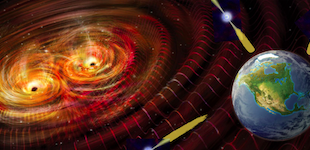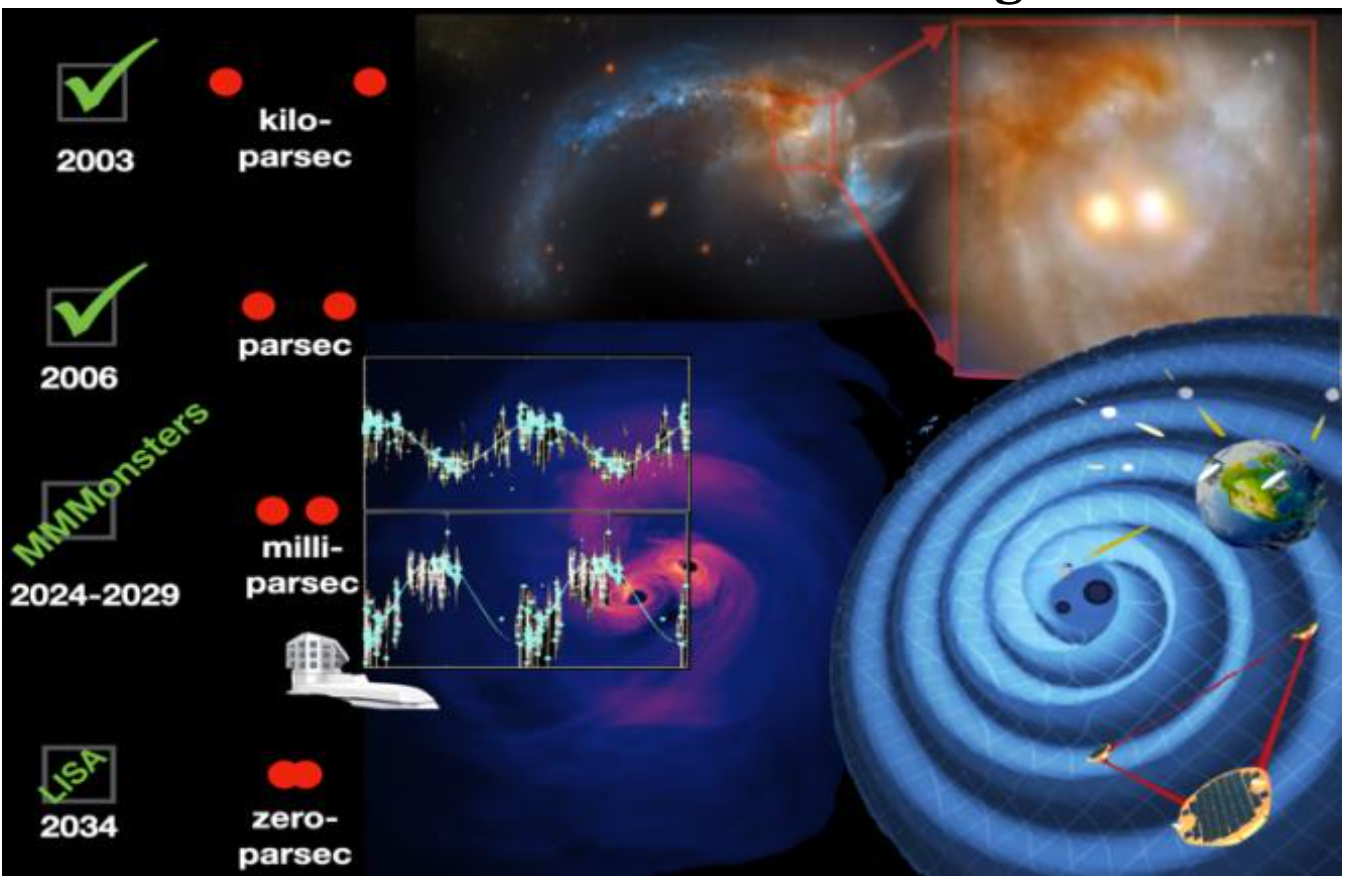MMMonsters: The first multi-messenger detection of a supermassive black hole binary

Supermassive black hole binaries (SMBHBs) are a natural outcome of galaxy mergers. They can be identified as quasars with periodic variability in time-domain surveys, or from strong gravitational waves (GWs) by Pulsar Timing Arrays (PTAs), making them exceptional multi-messenger sources. Despite their expected ubiquity, they have remained undetected, but upcoming data of unprecedented quantity and quality from the Legacy Survey of Space and Time (LSST) and increasingly more sensitive PTAs will bring these multi-messenger monsters (MMMonsters) within reach.

MMMonsters at the intersection of astronomy and data science is an ambitious program to deliver the first multi-messenger detection of a SMBHB. Leveraging existing time-domain data and the upcoming LSST dataset, we will improve SMBHB searches. On the GW side, we will pave the way for the first PTA detection of an individually resolvable binary, incorporating EM data from galaxy catalogs and through the joint analysis of time-domain and PTA data. This approach has the potential to accelerate the first detection of a SMBHB and allow the subsequent identification of the binary host galaxy.
MMMonsters will establish strong EU leadership in time-domain astronomy and GW physics through groundbreaking results and by training early career scientists in the emerging field of multi-messenger astrophysics. Students of all levels (undergraduate, Masters, PhD) and postdocs interested in research related to the above topics are highly encouraged to contact Dr. Maria Charisi.
Every massive galaxy has a supermassive black hole with mass from a million to ten billion times the mass of the Sun. Moreover, throughout the history of the universe, galaxies merge often to form bigger more massive galaxies. Each merger naturally produces a post-merger galaxy with two supermassive black holes, one from each parent galaxy. As the merger progresses, the two black holes orbit at smaller and smaller separations, until their final coalescence.
Observationally, we often detect galaxies at the initial stages of galaxy mergers. Additionally, over the last two decades we have resolved dozens of galaxies with two active supermassive black holes (so-called dual AGN) separated by kilo-parsec distances. As the two black holes orbit at smaller and smaller separation, it becomes more and more challenging to take an image of a galaxy and resolve the two supermassive black holes. At parsec scale, they can be resolved with Very Long Baseline Interferometry (i.e. using the entire earth as a telescope), but at smaller separations resolving them with direct imaging becomes almost impossible.
As a result, sub-parsec binaries have escaped detection, despite their expected ubiquity and decades-long observational efforts. One promising method is to detect quasars the brightness of which changes periodically. Over the last decade, time-domain surveys (which systematically scan the sky and record the brightness evolution for millions of sources) have allowed for systematic searches in large samples of quasars and have revealed a few hundreds of candidates. However, it is hard to confirm their binary nature, because the periods are long so we cannot observe many cycles of periodicity and quasars have stochastic variability which can mimic periodicity. MMMonsters will use existing time-domain data and data from the upcoming survey of the Rubin Observatory and develop new techniques to improve the search for quasar periodicities.
Supermassive black hole binaries also emit low-frequency gravitational waves, which are now targeted by Pulsar Timing Arrays and in the future with space-based interferometers like LISA. PTAs are a galactic scale detector that monitors dozens of milli-second pulsars. A passing GW induces coherent deviations in the arrival time of pulsar signals that are spatially correlated with a characteristic quadrupolar pattern. As of the summer of 2023, all major PTA collaborations have detected evidence for a low-frequency GW background. Even though its origin is still uncertain, it is likely that this background is produced by many unresolved supermassive binaries. In that case, GWs from loud binaries from massive and nearby galaxies may be detected within a few years. MMMonsters aims to improve the GW searches for supermassive black hole binaries by incorporating electromagnetic information. For instance, we have recently demonstrated that PTAs and time-domain surveys can probe the same population of binaries. In addition, performing targeted searches (e.g., towards EM-selected candidates) can boost the search sensitivity of PTAs.
Relevant papers
- Review on dual AGN and binaries (De Rosa et al., incl. Charisi, 2019)
- Quasar periodicity searches (Charisi, et al., 2016, Witt, Charisi, et al., 2022)
- EM signatures of supermassive binaries (D’Orazio, Charisi, 2023)
- Evidence for a low-frequency GW background (Agazie et al., incl. Charisi, 2023)
- Astrophysical interpretation of the GW background (Agazie et al., incl. Charisi, 2023)
- Astrophysics with Pulsar Timing Arrays (Burke-Spolaor, et al., incl. Charisi, 2019)
- Multi-messenger signatures of supermassive black hole binaries (Charisi, et al., 2022, Kelley, Charisi, et al., 2019)
